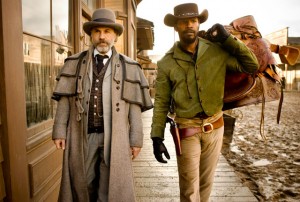Django Unchained
Django Unchained, 2012, 1 ¾ stars
Tarantino unchained and undisciplined

Christoph Waltz and Jamie Foxx star in Django Unchained. (image copyright the Weinstein Company / Columbia Pictures)
From The Orlando Weekly, December 19, 2012
In Quentin Tarantino’s Old South, white men are evil; black men are either submissive, simpering Uncle Toms or savagely beaten on a regular basis; and nearly everyone utters the n-word and f-word more frequently than a 19th-century Charleston slave auctioneer. In short, subtlety is, well, gone with the wind.
Django Unchained is the story of Django (Jamie Foxx), a slave in the pre-Civil War Deep South. He’s on a mission to find and free his wife, from whom he was separated when the two were sold to different owners. Fortune smiles on him when he meets Dr. King Schultz (Christoph Waltz), a German working in pre-Civil War United States as a bounty hunter. Schultz buys Django, hoping the slave can help him in his brutal business. If Django does what he’s told, Schultz, an anti-slavery advocate and seemingly the only decent Caucasian in the entire South, promises to not only grant Django his freedom but help rescue his wife, Broomhilda (Kerry Washington).
Along the way, the two meet a colorful assortment of characters, including Mississippi plantation owner Calvin Candie (Leonardo DiCaprio), Candie’s head “house slave” (Samuel L. Jackson) and, in a delicious cameo, a character played by Franco Nero, the star of the original Django, the 1966 spaghetti Western that inspired Tarantino. The entire cast, in typical Tarantino fashion, is mesmerizing and moves the stylistic, gripping narrative along quite well until, in the final act, it unravels faster than Scarlett O’Hara’s petticoat on her wedding night.
Tarantino’s love of violence clearly goes beyond a stylistic admiration and into the realm of fetish. In his earlier works such as Reservoir Dogs and Pulp Fiction, violence, though sometimes gratuitous, usually served a purpose, but in Django Unchained, it’s just stupidly over the top, as it was at times in the Kill Bill films. And with the use of unrealistic special effects, the brutality becomes even more laughable. Only Tarantino could make Martin Scorsese resemble Frank Capra.
Admittedly, calling Tarantino unrealistic is not a valid criticism. He rightfully subscribes to the notion that a film is not a photo, but rather a painting, with a variety of styles to choose from. The director obviously prefers expressionism to naturalism, and few do it with more critical and popular acclaim. It’s just a shame that his brushstrokes had to be so broad this time.
Tarantino’s most ardent admirers would expect no less, however, and will likely love the director’s latest Western-style epic and its bloated, nearly three-hour runtime. But more discriminating viewers will be upset that the film falls far short of his previous project, Inglourious Basterds. Even more disappointing is that someone with such a mastery of the craft of filmmaking can make such unfathomably bad artistic choices.
I’ve always wondered whether Tarantino would finally grow up. But after seeing his latest spectacular, bloody mess of a movie, frankly, I don’t give a damn.
© 2012 Orlando Weekly / MeierMovies, LLC
Writer’s note: This review generated controversy when originally published, as it was, for a time, the only negative review of the film on Rotten Tomatoes. So, essentially, it busted the movie’s 100-percent rating. I was called everything from a racist to a worthless, ignorant human being. If everyone who ever criticized Tarantino and mentioned Gone With the Wind were branded a racist, I’m not sure we’d have any non-racists left. (On a topic best left discussed in detail elsewhere, I’ll always defend the assertion that Gone With the Wind is NOT racist and is, in many ways, actually a subtle commentary on a certain side of the South, i.e., soft racism. However, there is no question it is a Romanticized portrait of only one particular version of the Old South and never attempts to depict a realistic version of the entire South and the horrors of slavery. Critics of GWTW should also note that Selznick was so disturbed by racism and the plight of his fellow Jews in Germany at the time that he went to great lengths to be as sensitive as possible and even sought the input of the NAACP. It was, in fact, the NAACP that insisted on deletion of the n-word and Ku Klux Klan references.)
The most interesting debate regarding my Django Unchained review centered on my assertion in the original version of the article that Tarantino had resorted to unrealistic computer-generated effects. Although Tarantino is known for rejecting CGI, and I applaud him for that, he DID make use of digital manipulation in post production in at least one scene. After an interesting e-mail conversation with the special-effects editor of the film, The Orlando Weekly ran a correction of my original review to simply criticize the “special effects,” not the digital effects. So while my original assertion concerning digital manipulation was not entirely inaccurate, depending upon your own definition of “digital manipulation,” it might have led readers to the false conclusion that some effects were digitally generated, which is not true. Thanks for keeping me on my toes, you crazy, passionate Tarantino fan basterds!
And for a laugh, see this.